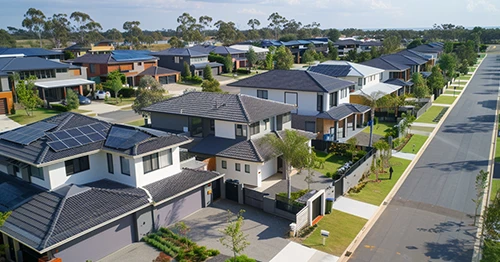Updated: 24 Dec, 2024
CoreLogic’s Home Value Index fell 0.14% in February 2023. This is the smallest monthly drop we’ve experienced since the cash rate started going up in May last year.
Sydney’s dwelling values rose 0.3%; however, other capital cities’ did go down. Hobart’s and Darwin’s recorded steep falls of 1.4% and 0.3%, respectively.
Is The Australian Housing Market Finally Finding Stability?
CoreLogic research director Tim Lawless said the stabilisation in housing values coincides with consistently low advertised supply and a rise in auction clearance rates.
“The past four weeks have seen the flow of new capital city listings tracking 17.0% lower than a year ago and 11.9% below the previous five-year average. This trend towards a below average flow of new listings has been evident since September last year, coinciding with the loss of momentum in the rate of value decline.”
Auction clearance rates bounced back in February. The capital city weighted average reached the 60% range through the second half of the month. Sydney’s clearance rates rose above 70% in the week ending 19 February.
Property Market Highlights
Here’s a summary of the major data points from the Australian property market in February 2023:
- Values in the upper quartile of the combined city housing market increased by 0.1%. Even when values fell, the lower values of the market also stabilised.
- And values were down just 0.1% across the lower quartile and 0.3% across the broad middle of the market. Sydney’s upper quartile experienced a 0.7% rise in values, compared with a 0.2% fall in the lower quartile market.
- Regional values were down 0.3% in February, compared with a 0.1% fall across combined capital cities.
- The combined regionals index is down 7.7% since peaking in June 2022. Regional housing values remained 30.7% above levels recorded at the onset of the pandemic, while the combined capitals index was 10.4% higher.
- In the four weeks ending 26 February, there were 11,250 more new listings than in the previous four-week reporting period. The total number of new listings was 38,118, but this is still 12.6% below the previous five-year average for this time of year.
- The total number of listings in the four weeks to 26 February was 143,500, which was 26.3% lower than the previous five-year average for this time of year.
- Against the low advertised stock levels, there was a strong rebound in the volume of sales. The monthly lift in sales nationally was 39.4%, comparable to February 2021 and 2020.
- The unit sector of the three largest capitals experienced the highest rental appreciation, led by a 16.7% jump in Sydney unit rents over the past year. Weekly rental values for units are currently 19% higher than at the onset of the pandemic in Sydney, 10.4% higher in Melbourne and 23.6% higher in Brisbane.
- The surge in unit rents was due to the return of overseas arrivals and higher demand for high-density rental options, which cost less to rent.
- The annual growth of house rents has slowed. For the combined capital cities, annual growth in house rents stabilised at 9.5% over the past four months; however, the quarterly trend does indicate a further slowdown in the rental growth rate for houses.
- Across combined capitals, gross dwelling yields hit bottom, at 2.96% in late 2021 and early 2022. Since then, they have risen 69 basis points, to 3.65%, the highest since October 2019.
What Risks Still Remain For The Housing Market?
Even with the signs of housing market stabilisation, there are still some risks.
- The Reserve Bank of Australia is expected to continue to increase cash rates over the next few months.
- Some of the big four banks have predicted the cash rate will peak at 4.1% between May and June. This would bring the average variable mortgage rate for new owner-occupier loans to around 6%.
- The fixed-rate cliff is imminent. The full effect of the aggressive rate hikes is yet to be experienced by borrowers.
- APRA asserted that its three percentage point serviceability buffer will remain in place.
- A decline in borrowing power could re-accelerate housing market declines. Consumer sentiment fell further with more news of rate rises. Homebuying decisions will be delayed for longer.
- Some homeowners could be forced to sell due to serviceability challenges.
- Pent-up supply is building as sellers remain on the sidelines. If there are new listings without an increase in buyer demand, there could be additional downward pressure on housing values.
In the longer term, Australia’s property market can recover. There is strong demand from overseas arrivals in Australia’s rental market. Buyer demand could increase, with the cash rate expected to stabilise later in 2023 or early 2024.






